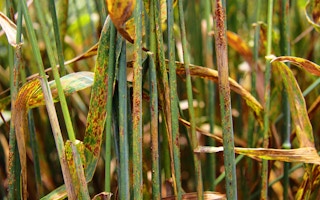Climate change is likely to kill back some crop diseases in tropical countries of the global South, with the disease risks instead rising in more northerly regions such as Europe and China, a study says.
However, this is expected to be accompanied by a shift in yields, with crop productivity stalling in tropical regions and rising in more northerly latitudes, according to the study published this week (5 August) in Nature Climate Change.
Plant pest and disease outbreaks have caused massive food shortages and famines over the years, killing millions.
“Plant pathogens already threaten agricultural production globally and we need to prepare for how these threats will change in the future,” says Thomas Chaloner, an author of the study from the University of Exeter, who now works as a data analyst at CABI, the parent organisation of SciDev.Net.
The researchers from the UK and Netherlands looked at 80 fungus-like diseases affecting crops.
Using crop and climate models, they analysed current (2011-2030) yields and future (2061-80) yield projections for 12 important crops, including wheat, maize, sugar cane, millet and soybean.
“
Though climate change is a worldwide phenomenon, its impacts are not felt equally across the globe.
Koteswararao Kundeti, climate researcher, Centre for Climate Change and Sustainability at Azim Premji University
The study suggests that, in tropical countries, climate change will decrease the yields of several crops, despite leading to a decline in crop disease.
“This is because temperatures will become too high for both the crops and their pathogens,” explained Dan Bebber, an author of the study and associate professor of ecology at the University of Exeter, UK.
The researchers predicted that, over the 21st century at lower latitudes, reductions may be seen in the yields of millet, maize and sugar cane but these crops will face a decreased risk from a number of infections.
In tropical areas, there will be little gain in yields of wheat, sunflower and soybean, but again the risk from various temperature-dependent pathogens will be less.
“For farmers in the tropics, breeding of crops for high temperature tolerance is important, as well as management to help crops deal with high temperatures, such as irrigation,” added Bebber.
Taking into account a situation where no irrigation is provided, maize yields were projected to decrease in Latin America —with the exception of Argentina — and in Africa and northern Australia, the study said.
There was also a projected decrease in the productivity of sugar cane in Brazil and other Latin American countries and in Southeast Asia.
Researchers forecast an increase in the risk of temperature-dependent infections in Europe and China, but a decrease in India, Brazil, Sub-Saharan African and Southeast Asian countries.
However, Bebber struck a note of caution about the crop disease projections. “First, we did not investigate all known pathogens due to a lack of relevant data, particularly for tropical pathogens. Second … pathogens might evolve to cope with higher temperatures,” he said.
Jonathan Casey, climate change manager at CABI, says the research demonstrates that climate change impacts all aspects of crop production, and will significantly change the pest and disease threats faced by farmers.
“These findings can help inform early warning and early action for farmers in affected regions — particularly in more northern regions — to take timely action to adapt to the increased pressures brought about by climate change,” said Casey.
Koteswararao Kundeti, a climate researcher at the Centre for Climate Change and Sustainability at Azim Premji University, in Bangalore, India, said: “Though climate change is a worldwide phenomenon, its impacts are not felt equally across the globe.
“Most of the developing countries that lie in between the tropics are especially vulnerable to climate change. Global climate models’ projections indicate that we need to prepare for extreme weather conditions, with more droughts, heavy rainfall, and storms in regions of high agricultural production.”
This article was originally published on SciDev.Net. Read the original article.










